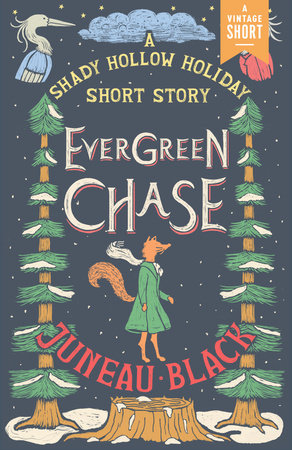 Evergreen Chase: A Shady Hollow Mystery Short Story by Juneau Black
Evergreen Chase: A Shady Hollow Mystery Short Story by Juneau Black Format: ebook
Source: purchased from Amazon
Formats available: ebook
Genres: cozy fantasy, cozy mystery, holiday fiction
Series: Shady Hollow #3.5
Pages: 32
Published by Vintage Crime/Black Lizard on November 30, 2021
Purchasing Info: Author's Website, Publisher's Website, Amazon, Barnes & Noble, Kobo
Goodreads
It’s the winter solstice in Shady Hollow, that magical time of year when creatures of all shapes and sizes come together to honor the season and eat as much pie as possible. Reporter Vera Vixen is eager to experience her first holiday in town and is especially looking forward to the unveiling of the solstice tree. But then disaster strikes. The year’s tree—the tallest in the forest—has disappeared without a trace. Can Vera, her best friend, Lenore, and Deputy Orville Braun find the tree and save the season? Or will this year’s solstice be especially dark?
My Review:
Today is Black Friday in the U.S., that unofficial holiday after the official Thanksgiving Day holiday.
Traditionally, this was the day when holiday decorating ‘officially’ kicked off, and anyplace that had not already started playing Xmas carols started doing so with a vengeance. So, as this feels like the right day, at least to me, to start reviewing holiday books, I’m kicking off my holiday season with this Shady Hollow winter solstice story.
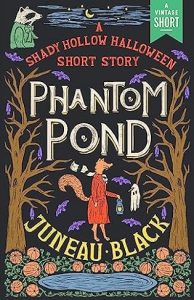 This is explicitly not a Christmas story, just as Phantom Pond was not explicitly a Halloween story. The historical and religious underpinnings of both of those holidays in our world don’t exist in the animal-centric world of Shady Hollow.
This is explicitly not a Christmas story, just as Phantom Pond was not explicitly a Halloween story. The historical and religious underpinnings of both of those holidays in our world don’t exist in the animal-centric world of Shady Hollow.
But that doesn’t mean that something like those holidays wouldn’t, doesn’t or hasn’t arisen in other cultures – and that particularly applies to the winter solstice. Many, many traditions have holidays around the solstice, and Shady Hollow wouldn’t be exceptional in marking the shortest day of the year – even if they might be a bit exceptional in just how they do that marking.
Along with the touch of mystery that makes the series so very much fun!
The tradition in Shady Hollow is to ‘walk’ the specially chosen Solstice tree from the surrounding woods to the center of town, where it will be decorated and feted and brightly lit to chase away the darkness of the longest night.
The trees are chosen decades in advance and tended lovingly by specially appointed treekeepers until their appointed day as the center of the whole town’s attention and celebration.
But someone has stolen this year’s tree – all FIFTY FEET of it – the night before its celebratory walk. The whole town is enraged, incensed, and practically in mourning over the loss of their tree.
It will take the efforts of every animal in town, from Police Bear Orville Braun to ace investigative reporter Vera Vixen to all the birds around town, led by night-owl Professor Heidegger and bookstore owner Lenore the Raven to find the tree in time.
The longest night comes early in Shady Hollow, and time is running out.
Escape Rating B: Shady Hollow may sound a bit twee, but it’s really a LOT more like Zootopia – at least if the movie had been set in Judy Hopp’s rural Bunnyburrow instead of Nick Wilde’s big city. A reflection that reporter Vera Vixen frequently makes herself, as she used to be a resident of one of those big cities but has found cozy Shady Hollow to be a lot more to her taste.
The Shady Hollow series as a whole, are lovely, charming, and very cozy mysteries – and Evergreen Chase is no exception. At the same time, the use of animals as people gives the author all sorts of opportunities to include comments about human behavior hiding in plain sight – or under the bare covering of a pawkerchief.
Like many of the stories in this series, there’s a mystery, but it’s a gentle one. No one is dead, no one is likely to end up dead, but the town’s collective anguish is still VERY real, as someone has literally stolen one of their beloved traditions right out from under them.
 That the town pulls together to celebrate the solstice with or without the tree is all part of the series’ charm. That they have their own solstice miracle just adds to the sweetness of both the story and the holiday season – both theirs and ours.
That the town pulls together to celebrate the solstice with or without the tree is all part of the series’ charm. That they have their own solstice miracle just adds to the sweetness of both the story and the holiday season – both theirs and ours.
So this feels like its a short story for the many fans of the series, of which I am mostly definitely one. And it turned out to be the perfect start for my holiday reading. (As much as I enjoyed The Wishing Bridge reading it last week made me want to give myself a ‘ten-yard penalty for rushing the season.’ Reading Evergreen Chase felt like a ‘proper’ start to the season.)
It did also remind me of another lovely holiday story that uses animals to tell an entirely different but equally charming human story. If Shady Hollow sounds charming but you’ve never watched Emmet Otter’s Jug-Band Christmas, well, let this be the season to get the song, “There Ain’t No Hole in the Washtub” stuck in your head, just like it is in mine this time of year!
~~~~~~ GIVEAWAY ~~~~~~
Black Friday is just a weird day. It’s not a holiday, but it still feels like part of a holiday. Unless one works in retail, because it’s most definitely, absolutely not a holiday under those conditions! Also weird, but along the U.S./Canadian border, even though there is no Thanksgiving Thursday in Canada (Canadian Thanksgiving is in mid-October), there is mostly definitely a Black Friday complete with Black Friday sales.
But it’s a day when not many people may be reading blogs – possibly because in the U.S. they are either still in a turkey coma or because they’re off trying to grab the best Black Friday deals. So, for those who are staying home, I have a bit of a giveaway for you.
It’ll just be a little something to put in someone’s holiday stocking, but it’s just a way to say ‘THANKS!’ to all of you who have spent a bit of time with me over the year at chez Reading Reality.

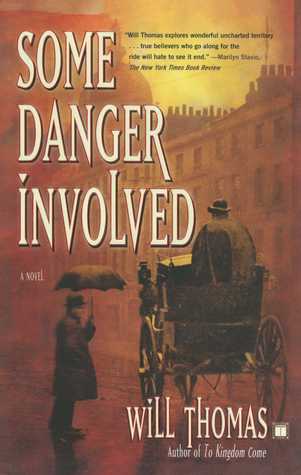 Some Danger Involved (Barker & Llewelyn, #1) by
Some Danger Involved (Barker & Llewelyn, #1) by 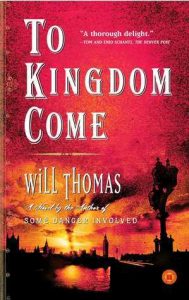 (Although my own family was still spread across Eastern Europe at this time period, I have pictures of my great-grandfather, and this would have been his generation, letting me connect to this story on a deeper level than I expected – which is where those multiple levels of comfort read come comfortably in.)
(Although my own family was still spread across Eastern Europe at this time period, I have pictures of my great-grandfather, and this would have been his generation, letting me connect to this story on a deeper level than I expected – which is where those multiple levels of comfort read come comfortably in.) Murder at the Royal Botanic Gardens (Wrexford & Sloane, #5) by
Murder at the Royal Botanic Gardens (Wrexford & Sloane, #5) by 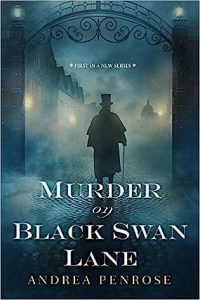 This fifth book in the
This fifth book in the  Before Charlotte can be truly happy, all of those swords hanging over her head have to be carefully taken down, while she and Wrexford are in the midst of solving a criminal conspiracy that turns out to have more heads than Hydra. That the sheer tangle of threats coming their way makes both of them realize just how many hostages to fortune they have gathered around themselves over the course of their investigations adds to Charlotte’s worry and angst.
Before Charlotte can be truly happy, all of those swords hanging over her head have to be carefully taken down, while she and Wrexford are in the midst of solving a criminal conspiracy that turns out to have more heads than Hydra. That the sheer tangle of threats coming their way makes both of them realize just how many hostages to fortune they have gathered around themselves over the course of their investigations adds to Charlotte’s worry and angst.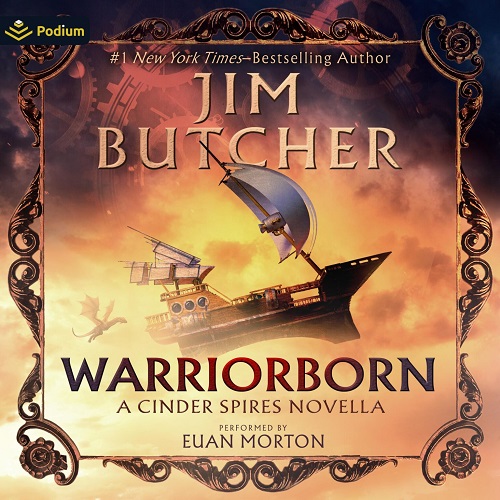 Warriorborn: A Cinder Spires Novella (The Cinder Spires) by
Warriorborn: A Cinder Spires Novella (The Cinder Spires) by 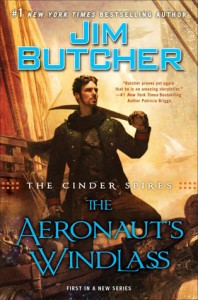 Warriorborn is the perfect method for readers who remember the first book in the
Warriorborn is the perfect method for readers who remember the first book in the 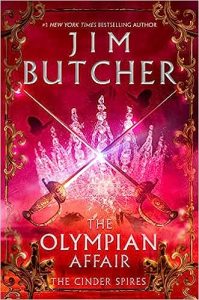 Escape Rating A-: I picked this up this week because I was having a “flail and bail” kind of day. Post Halloween, I was horror’ed out. Even at the horror-adjacency level I’m more comfortable in. I hit the “I can’t evens” and went looking for something a bit more comforting. This would not, I admit, normally have filled that bill, but the NetGalley app was having a flail of its own which is now fixed, but at the time was knocking me out of the book I’m listening to.
Escape Rating A-: I picked this up this week because I was having a “flail and bail” kind of day. Post Halloween, I was horror’ed out. Even at the horror-adjacency level I’m more comfortable in. I hit the “I can’t evens” and went looking for something a bit more comforting. This would not, I admit, normally have filled that bill, but the NetGalley app was having a flail of its own which is now fixed, but at the time was knocking me out of the book I’m listening to.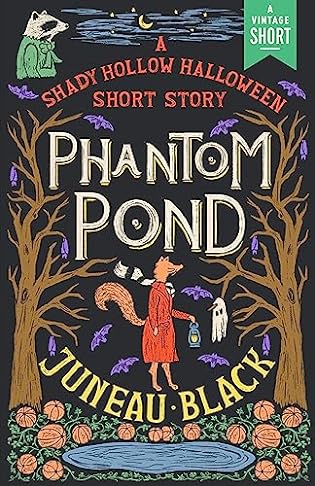 Phantom Pond: A Shady Hollow Halloween Short Story by
Phantom Pond: A Shady Hollow Halloween Short Story by 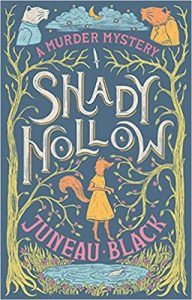 Every society seems to invent a holiday where its denizens can let their hair down, or at least loose the stays on the stricter rules of society, for a day or two – even if they don’t turn those rules completely topsy-turvy.
Every society seems to invent a holiday where its denizens can let their hair down, or at least loose the stays on the stricter rules of society, for a day or two – even if they don’t turn those rules completely topsy-turvy.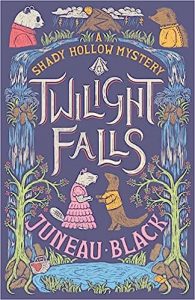 When one of the little Mischief Night revelers doesn’t turn up the following morning, not at home, not at her best friend’s house, not anywhere – and a vaguely threatening missive from Creeping Juniper is found in her place – everyone fears the worst.
When one of the little Mischief Night revelers doesn’t turn up the following morning, not at home, not at her best friend’s house, not anywhere – and a vaguely threatening missive from Creeping Juniper is found in her place – everyone fears the worst.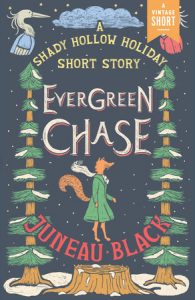 Then it turns the whole scenario on its head, one more time, into the best kind of cathartic happy ending about mysterious misunderstandings until all their, and our, fears are laid peacefully to rest but no character is left under a ‘Rest in Peace’ marker.
Then it turns the whole scenario on its head, one more time, into the best kind of cathartic happy ending about mysterious misunderstandings until all their, and our, fears are laid peacefully to rest but no character is left under a ‘Rest in Peace’ marker.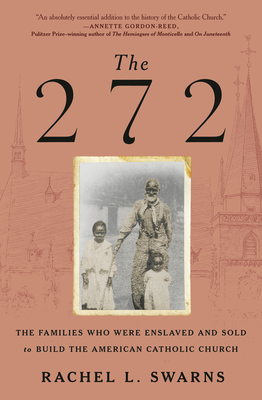 The 272: The Families Who Were Enslaved and Sold to Build the American Catholic Church by
The 272: The Families Who Were Enslaved and Sold to Build the American Catholic Church by 
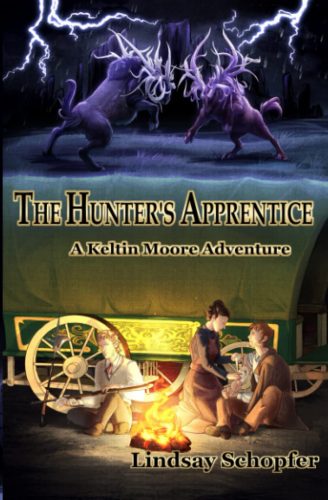 The Hunter's Apprentice: A Keltin Moore Adventure (The Adventures of Keltin Moore #4) by
The Hunter's Apprentice: A Keltin Moore Adventure (The Adventures of Keltin Moore #4) by  Keltin Moore’s fourth adventure represents a turning point for the famous Beast Hunter AND his family of choice in this fantasy-tinged, steampunk-powered series. When his story began in
Keltin Moore’s fourth adventure represents a turning point for the famous Beast Hunter AND his family of choice in this fantasy-tinged, steampunk-powered series. When his story began in 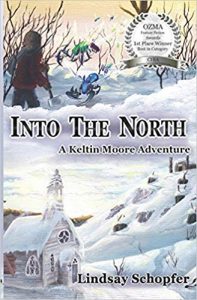 Escape Rating A: I read the second book in this series,
Escape Rating A: I read the second book in this series, 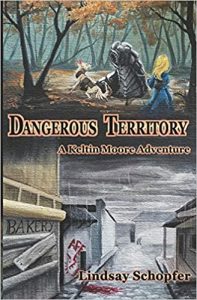 It’s an outsider’s inside view and the reader learns as much as Keltin does.
It’s an outsider’s inside view and the reader learns as much as Keltin does.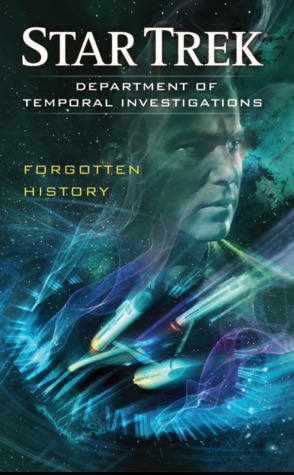 Forgotten History (Star Trek: Department of Temporal Investigations, #2) by
Forgotten History (Star Trek: Department of Temporal Investigations, #2) by 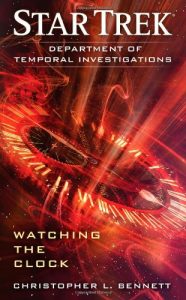 But Kirk, for all of his temporal escapades, and in spite of the way that DTI investigates the ways and means in which time looks back on itself, is more than a century in their rear view mirror. So to speak. And as DTI Agents Lucsly and Dulmur discovered in the first book in the DTI series,
But Kirk, for all of his temporal escapades, and in spite of the way that DTI investigates the ways and means in which time looks back on itself, is more than a century in their rear view mirror. So to speak. And as DTI Agents Lucsly and Dulmur discovered in the first book in the DTI series, 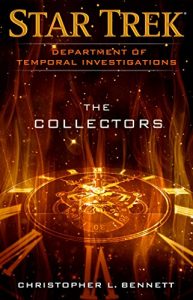 Which means that, while I did like Forgotten History quite a bit, a good bit of that is due to the high nostalgia factor in going back to the era of
Which means that, while I did like Forgotten History quite a bit, a good bit of that is due to the high nostalgia factor in going back to the era of 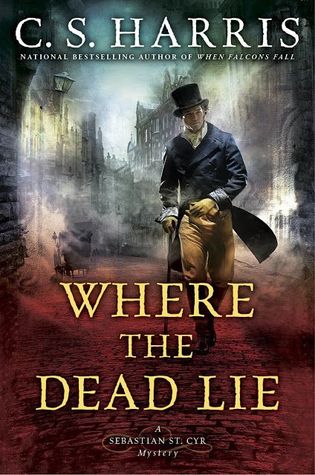 Where the Dead Lie (Sebastian St. Cyr, #12) by
Where the Dead Lie (Sebastian St. Cyr, #12) by 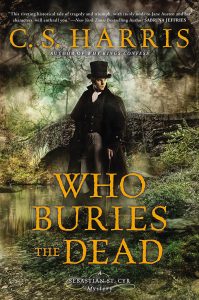 The dead lie in multiple meanings of the word AND in multiple places in this twelfth entry in the long-running, utterly marvelous
The dead lie in multiple meanings of the word AND in multiple places in this twelfth entry in the long-running, utterly marvelous 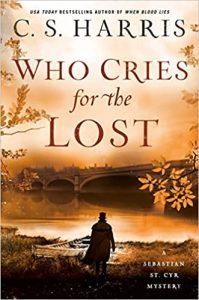 Escape Rating A-: This one is a really hard read. It’s excellent, just as the entire
Escape Rating A-: This one is a really hard read. It’s excellent, just as the entire 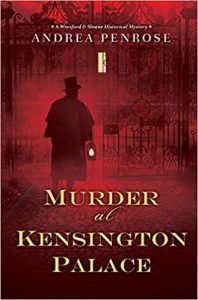 With one child’s, as well as their mother’s, tragedy yet to come in the later books in the series.
With one child’s, as well as their mother’s, tragedy yet to come in the later books in the series. Wild Spaces by
Wild Spaces by